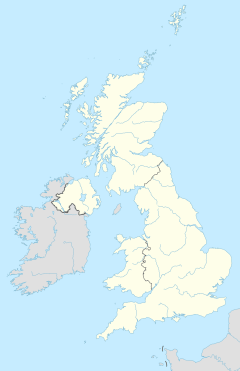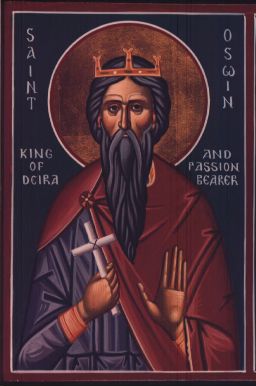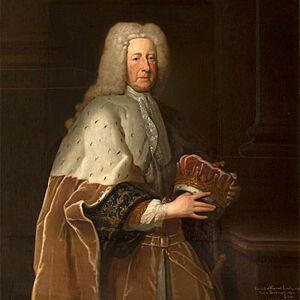Didderston facts for kids
Didderston (also known as Dirdreston or Wilfar's Hill) was a medieval manor, which is like a large estate, located in the Melsonby area of North Yorkshire, United Kingdom. It was mentioned in the Domesday Book of 1086 as Dirdreston Grange. Today, experts believe Didderston was located around Diddersley Hill, and the farms called Low Grange and High Grange. Didderston has a long history, possibly starting as early as 651 A.D. and continuing until the 1600s.
Quick facts for kids Didderston
|
|
|---|---|
| Civil parish |
|
| Shire county | |
| Country | England |
| Sovereign state | United Kingdom |
Contents
An Ancient Place: Wilfar's Hill
The story of Didderston might go back to the 7th century. A famous historian named Bede wrote about the death of King Oswine in 651 A.D. King Oswine was a ruler of a kingdom called Deira.
Bede described a place called "Wilfaresdun," which means "Wilfar's Hill." He said it was about ten miles northwest of a village called Catterick. King Oswine had gathered his army there. But he decided to send his soldiers home. He then went to hide with a trusted friend, Earl Hunwald. Sadly, Earl Hunwald betrayed him. King Oswine was then killed by King Oswy's commander.
Historians believe that Wilfar's Hill is actually Diddersley Hill. This hill is near Catterick, just as Bede described. This connection makes Didderston a very old and historically important place.
Didderston's Early History
Even if the 7th-century link is a guess, we know for sure that Didderston was important much later. By the 1200s, part of Didderston manor was a "grange" of Jervaulx Cistercian Abbey. A grange was like a farm or estate owned by a monastery.
Didderston was also one of the estates belonging to Thorfin of Ravensworth. Thorfin was an important horse-thegn (a type of noble) to the Earl of Northumbria. This was during the time of King Edward the Confessor (before 1066). Ravensworth is only about three miles from Diddersley Hill. This fact helps support the idea that Didderston was once Wilfar's Hill. Thorfin is considered the first known lord of Didderston. His family line can be traced right up to later lords.
The Manor and Its Lords
In 1086, the Domesday Book recorded Didderston as "Dirdreston Grange." It was home to about 9.5 households. It had four "carucates" of land. A carucate was an old way to measure land, roughly 120 acres. So, Didderston had about 480 acres.
The Domesday Book said:
In Malsenebi and Dirdreston, a berewick, for geld, eleven carucates, and ten ploughs may be [there]. Torfin had one manor there; now, Bodin has one plough there, and fifteen villanes and three bordars with seven ploughs. A church is there, and a priest. The whole, one leuga in length and one in breadth. T. R. E., it was worth forty shillings; now, thirty shillings.
In this vill there are four caucates for geld, of which the soke belongs to Ghellinges.
This old record tells us that Didderston was a "berewick" (a small village or hamlet) and a "vill" (a village). It also mentions a church and a priest. This suggests it was an active community, not just empty land.
Grange Castle Remains
Today, you can still see the remains of "Grange Castle" at Didderston. These are rectangular earthworks, like old walls made of earth. They are about 200 feet by 120 feet. They are surrounded by a larger moated earthwork. A moat is a ditch, often filled with water, around a castle or building.
Special maps made with LiDAR technology show that this structure was built on an old riverbed. It looks like the stream was used to fill the moat. The Domesday Book doesn't mention a castle at Didderston. This means the castle might have been built after 1086. However, because Didderston was a vill and had a "soke" (a legal area), it likely had some kind of important building. It's possible the structure has Anglo-Saxon origins, meaning it could be very old. Many ancient artifacts, including the Stanwick Hoard, have been found nearby.
Who Owned Didderston?
After Thorfin, Bodin of Penthièvre became the second lord of Didderston in 1086. Bodin was related to Count Alan Rufus. Later, Bodin decided to become a monk. He gave his lands, including Didderston, to his brother, Bardulf.
The manor stayed in Bardulf's family for about 300 years. In 1305, Adam FitzHugh inherited Didderston. He was the 10th Lord of the Manor. When Adam died, he gave Didderston to Jervaulx Abbey.
The abbey kept the manor for about 200 years. But then, in the 1500s, King Henry VIII dissolved the monasteries. This was called the Dissolution of the Monasteries. The abbey was closed in 1537, and Didderston went back to the Crown (the King).
In 1544, King Henry VIII gave Didderston to Matthew, 4th Earl of Lennox. Matthew's second son, Charles, became the 12th lord. When Charles died, Didderston went back to the Crown again.
In 1603, King James I gave Didderston to Edward Bruce of Kinloss. Edward Bruce had helped King James I become king. The lordship of Didderston eventually passed to Edward Bruce's great-grandson, Thomas Bruce, 2nd Earl of Ailesbury.
In 1696, the 2nd Earl of Ailesbury was put in prison. He was later sent away from the country in 1697. By 1699, the lordship of Didderston became "in abeyance." This means it didn't have a clear owner for a while. Since then, the lordship has been passed on to the current 18th lord of the manor.




